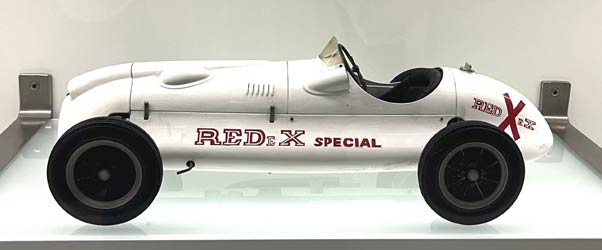

|
Home Updates Hydros Cars Engines Contacts Links ←Previous Contact On The Wire |
The Weaver Legacy
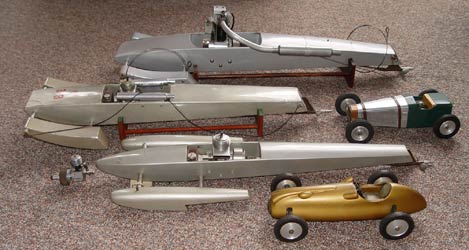
From what Gwyneth has told us and from what we have garnered from other sources it would appear that the two deaths in quick succession left her and her brother in a difficult situation, with only one of them on hand to sort out the complicated family affairs. It was certainly intended that Arthur’s cars, boats, engines and other models should stay with the family, yet for a variety of reasons, this did not happen. The hydroplane that won the Willis Cup at the 1974 ME Exhibition and much admired by one half of OTW that year joined the collection of Arthur Cockman, a long time friend of Arthur's and fellow competitor from Victoria.
A number of Arthur’s cars were on loan at the Stratford on Avon Motor Museum until the 28th February 1990 when the display case they were in was broken into and they were stolen, shortly before the museum closed permanently. The cars stolen were the number 3 ERA tethered car, the Hotchkiss and Sunbeam rail cars and the large Cooper Bristol that was missing its ETA motor. These have vanished without trace and not reappeared in the intervening years, although they would be instantly recognisable. Other cars, including the magnificent Sunbeam record breaker, and Cooper Bristol railcar, became part of the collection of long time associate and friend from Arthur’s time in Eccleshall, Gerry Buck from nearby Endon.
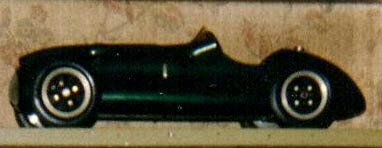 |
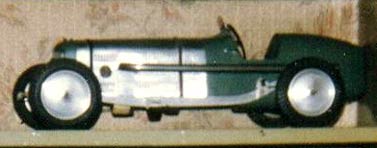 |
| Arthur's own Cooper Bristol without engine | ERA number 3 |
As well as the cars there were many of Arthur’s own and AMCO development engines, including the part finished Vee twin that has appeared in so many illustrations, and another hydro. A third hydro and more AMCO material was passed to Tony Taylor in Stafford who helped move Arthur and Mary down to Wales, whilst other items went to a nephew.
|
Following the death of Gerry Buck in 1981 all the items in his collection were gradually sold on. The large tethered cars again vanished without trace, but most of the smaller items and motors such as the unfinished V twin (right) were retained until a final ‘clearout’ where they were seen for the first time as a collection at Old Warden having been gathered together by John Goodall. With the exception of the Sunbeam, the four stolen from Stratford and the two cars still owned by his daughter, other items that have surfaced again over the last few years form the final part of the ‘Weaver story’. |
|
Hydro 'Gwyneth'
This boat was the first example of Arthur's work
that we saw in the flesh, back in 1974 at the ME Exhibition. Although the show
catalogue we saw recently lists it as 'Gwyneth' the contemporary reports name it
as 'Wizard of Oz', which it has been called ever since, until 2016 when we
learned of its true identity from Gwyneth. Looking back we can only
assume that the Exhibition entry was made prior to Arthur's death late in 1973 and
that following the exhibition it came into the possession of
Arthur Cockman.
|
All of the Cockman boats eventually went to Gerry Colbeck, secretary of the MPBA, who along with Stuart Robinson attempted to run some of them at the St Albans International Regatta. When the new National Powerboat Museum at Pitsea in Essex was being set up, Gerry loaned all his boats for permanent display. 'Gwyneth' changed hands again, and when the Museum closed was retrieved and restored as the first step of the Arthur Weaver 'appreciation' venture. |
|
|
|
Willis Challenge Cup certificate |
Engraved rocker cover |
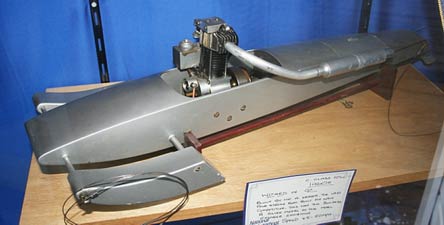 |
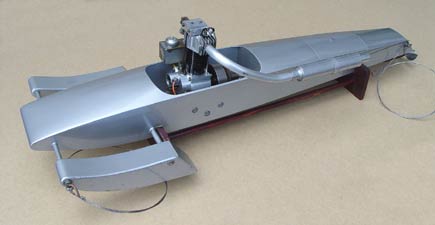 |
| On display at Pitsea clearly labelled 'Wizard of Oz' | Now known by its proper name 'Gwyneth' |
Hydro 'The Rumour'
More recently, hydro historian Peter Hill heard mention of a hydroplane having been found that was believed to be an Arthur Weaver hull. This was not a complete surprise as he had been sent pictures of one several years earlier from a collector in Bolton, but with no further details forthcoming it was not known if it was the same boat. In conversations we speculated whether it might be an early ‘Wizard of Oz’ or ‘Fleche D’Or’, but then all went very quiet for a long while and nothing more was heard of it.
|
In the meantime, it transpired, that amongst the collection of Weaver material that John Goodall had obtained was a motor that could possibly have been for a hydro and one with mounts and flywheel that definitely was intended for a boat. Could the mystery boat have been for either of these engines? It was academic as there was no further contact at that stage. Eventually it was revealed that the hull was in Derbyshire and had a V33
registration that confirmed it as a Weaver boat but with no further information.
This was exciting and frustrating at the same time, but some photos were obtained,
which opened up a whole new line of enquiry.
|
|
|
|
There was no doubt it was one of Arthur’s boats as it was an almost exact copy of ‘Gwyneth’, but what engine had it originally been built for? Searches of magazines revealed no further information and study of the pictures only served to indicate that the mounts were not intended to fit any of the engines in John’s possession. Peter Hill’s first thought was that it was intended for an ETA 29, which was the standard 5cc motor being used at the time. It was obvious that although very dirty, the hull was absolutely complete, even to the original flax bridles. Several more months were to pass before Peter saw the boat in the flesh, which enabled him to solve the mystery in double quick time. |
The hull, along with much of the material John Goodall had obtained, confirmed Weaver's connection with AMCO after the establishment of the new company at Alperton. A quick measure of the engine mounts and the odd positioning of the fuel knock-off, still with tube attached, established that the boat had been built for a standard AMCO 3.5 BB, something of an unusual choice for the 5cc class?
|
The hull had been stored somewhere very dry but exceedingly dirty so a great deal of elbow grease was required to get all the muck off and reveal the grey paint finish. ‘Gwyneth’ is grey metallic, but this is definitely metalflake, certainly a case of conservation rather than restoration, as this finish would be impossible to replicate. Also it is the only boat to retain the Victoria registration, which needed to be preserved. The joints that had opened up were reglued and then filled with evaporated metallic paint, as were the bare patches and major dings. Other than that, nothing more was done to the hull. |
|
|
|
|
The other interesting item was the bulkhead-mounted fuel tank. This penetrated the front bulkhead and an attempt to remove it had more and more coming out until it fouled the engine mounts. Engine mounts were unbolted and still the tank kept coming, until two cut-outs in the bottom corner of the flange just cleared the engine mount screws. It was a monster at over 3" long and measured up at 115cc, almost enough for a seasons running? The cut-off was something of a necessity and a remarkable piece of engineering alone. |
Subsequently it transpired that this was the boat given to Tony Taylor around 1968/9, and as this was not the one in the photos sent to Peter all those years ago it indicated that there was certainly another Weaver hydro in existence, and even better, its location was known.
|
|
With a correct 'Alperton' prototype AMCO BB by courtesy of Steve Betney and a lot of fiddling about with exhausts, the renovation was complete. No contemporary evidence about the silencers had come to light, so it was down to guesswork, TLAR and the existing holes to come up with the arrangement shown. A recent photo of a hitherto unknown Weaver hydro suggests that fishtail silencers may have been used. |
Hydro and motor reunited
|
Following the discovery and subsequent restoration of the hull intended for a standard AMCO 3.5 BB, the existence of a similar motor, complete with engine mounts (see right) was intriguing. Putting 'Gwyneth' beside this motor confirmed that the bolt spacing in the mounts exactly matched, but that the hull was much wider. Was there any possibility then that this motor might have originally been fitted to the hull in Bolton? There seemed little doubt that this was another of Weaver's hydros and through Peter, we were able to contact the then owner, who still had the boat, along with an ED Comp Special that he had fitted. |
|
|
|
Studying the photos that the owner kindly sent to us, it looked very likely from the pattern of the mounting holes and position of the hole for the fuel cut off, that the AMCO on its mounts would fit straight in to the hull. This thought was further strengthened when it was discovered that the boat as well as the engine had originated from the collection of the late Gerry Buck, although some 15 years apart. |
This posed an interesting challenge for OTW. We knew where both the hull and motor were, and knew both owners, so was there any possibility of reuniting the two items? However, after publishing a photo of the boat in Pitbox and suggesting the possibility to him, the owner of the hull indicated that he might be willing to part with it. Halfway there! At the Midland Exhibition we outlined the situation to John Goodall, for his thoughts. As far as OTW was concerned, the prime purpose was to get the engine and boat back together.
After negotiation, it was agreed that John would purchase the hull and make arrangements to collect it. At that stage a degree of nervousness crept in, as someone else was now taking the risk that our observations and thoughts might not be correct. Eventually John travelled up to Lancashire, and to our relief, found that his engine fitted Alan’s hull perfectly. Alan remarked that it was almost like a 'Time Team revelation' with each bolt lining up, one after the other. The following week John Goodall brought the complete boat down to the Old Warden Swapmeet for our perusal and a photography session.
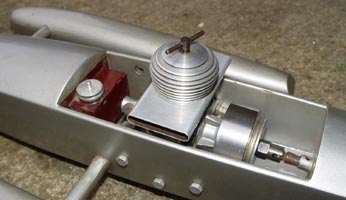 |
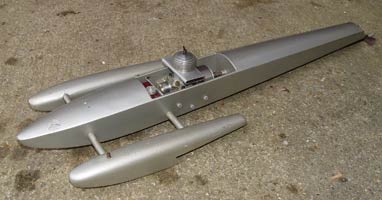 |
| Weaver modified AMCO back in the hull | Slight damage to the foredeck, but otherwise, perfect. |
What is immediately obvious is that apart from the exhaust extensions, there seems to be no provision for silencing so was the boat ever run, or indeed completed? There might be a clue in the position of the hole for the fuel cut off? It is positioned perfectly for a standard AMCO BB, yet the motor has a modified and more conventional rear backplate with a straight venturi. Was the motor removed for these mods and never refitted, or was it another development motor to replace a standard BB?
|
This card from the 1958 ME Exhibition has come as something of a surprise to all and it puts the AMCO engined boat above into its true context. For some reason neither the entry or the award of the Willis Cup and a silver medal had been recorded anywhere else. A trawl through the ME and a show guide for that year that we just happened to have had a single line in each that confirms Arthur winning the Willis twice, 1958 and 1974, a superb achievement. What is even more rewarding is that both boats have survived. There is still one hydro unaccounted for and that is a larger version of the cup winning boat fitted with an ETA 29 motor that can be seen in previous photos but has not been described anywhere, as far as we know, but as the card proves, there are still surprises out there. |
|
Cars 'The Mystery Cooper Bristol'
|
This started of with some photos that David Giles had been sent from Australia. He passed them on to see if we had any further ideas as to what the two cars might be. The first one was relatively simple as it was home built, using a selection of components from D.C. Howell of Eastbourne. It was the second car that was more interesting as it was a very close scale model of a Formula 2 Cooper Bristol, as raced by Mike Hawthorn amongst others. The front suspension and wheels were a very close copy of the original car, but someone had discarded the correct rear wheels for a pair of functional items. Apart from that piece of vandalism, it looked an extremely well made and accurate model and definitely something out of the ordinary. |
|
|
|
It was the photo on the left, taken with the bonnet off that piqued our curiosity, as nestling in there between a pair of angle aluminium rails was an ETA 29 and a very familiar fuel tank. The whole layout was very reminiscent of a series of models built in 1952/3 by Rex Hays, Arthur Weaver and Henri Baigent, but was one of them responsible for this car? It looked like the work of Weaver, but without photos of the drive, suspension mounts, gearbox etc, it was impossible to confirm this. An email was despatched asking for more detailed photos, and in the meanwhile it was another session of magazine searching for the relevant articles. |
|
When the extra photos arrived, it did not take long in comparing them with the originals to confirm that the mystery car was of Weaver origin. Every aspect of the chassis matched up with the pictures published in Model Maker, every screw, all the suspensions details, mountings, clutch and gearbox. Even the fuel cut-off bore a striking resemblance to the one in the hydro. |
|
|
|
|
There is no doubt that the entire chassis is one of Arthur Weaver’s, but whether the car is one of the others that he referred to in the article or an original REDeX example was not known until the owner had a pick at the paint and underneath the layers discovered an aluminium body shell and the original 'REDex' paint finish. This was the final confirmation that this was indeed one of the 'REDeX' Cooper Bristols, making it a very important car indeed. It is unfortunate that the rear wheels and wishbones have gone missing, but these could be replicated to replace what has been fitted. Certainly it was an exciting find as there has always been conjecture as to whether one of these cars had survived. |
Thanks to Rohan Cleary for all the photos and David Giles. (Photoshop for the new rear wheel)
|
Update May 2017:- Following an enquiry from a correspondent in Australia it was established that the car had been sold although we had no indication where it had gone to until we were contacted by Scott Clydesdale quite recently. He was aware of the car having been sold on yet again and was able to furnish the photo on the right showing the car in its current state. The blue paint has been removed as has the original REDeX paintwork, which is a pity, but it does reveal the quality of Arthur Weaver's sheet metalwork. Thanks to Scott for this information and photo that confirms that one of the Weaver REDex cars did survive, but as we also know from other material received, so do two others. |
|
The 'Experimental Railcar'
|
|
An eBay listing many moons ago piqued interest around the retro car fraternity as it was the bare chassis of a very unusual railcar, complete with the equally unusual and somewhat distinctive motor, a fuel tank that was almost an AFW trademark and the 'controversial zonkers'. Minimal research was required to establish that it was the remains of Arthur's 'Experimental railcar' NL 1952 illustrated and described in Model Maker in 1953. Contact with the vendor down in Wales established the provenance as he was Arthur's nephew, disposing of non aero related items he had acquired. |
|
The wheels and tyres that Arthur supplied for railcars were unusual in that the entire tyre and centre was moulded in one piece with aluminium discs attached either side. These were missing and there has never been any sign of any appearing for sale so conventional railcar hubs were substituted with tyres of almost the correct size being carefully removed from a set of Raylite centres. With the article to hand it was a realistic option to rebuild the car to its original specification, a job carried out to a very high standard by Mike Crisp. |
|
Cooper Bristol Railcar
The only complete and original railcar of Arthur's that was known to have survived was the Cooper Bristol in Gerry Buck's collection. Gerry's daughter and son in law retained this, along with other Weaver items, until the final 'grand clearout' a few years ago when we first saw it at Old Warden with the remainder of the Buck collection. The quality of workmanship was just amazing and reinforced just why we were so fascinated with what Arthur had produced over the years.
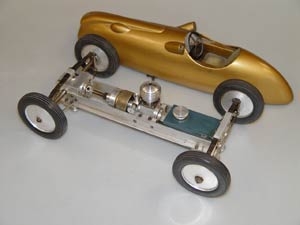 |
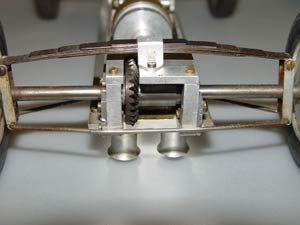 |
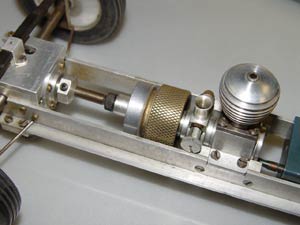 |
| Superb modelling throughout | Gearbox, zonkers and look-alike suspension | Drive train and variable induction timing |
Family Models
The Delage model below was built by Arthur in 1948/49 and based on the 1926 1.5 litre GP car. The motor is unusual as it is a 1cc, direct drive twinshaft. The 2 inch wheels give scale to this diminutive car, which is only seven inches long. The Delage radiator badge was made by fellow club member Ernie Rhodes, a professional blockmaker. The perfectly formed louvres evident on this car and the plethora of different sized ones on his ERA models were produced by a cutting roller setup that he described in detail in Model cars in 1950.
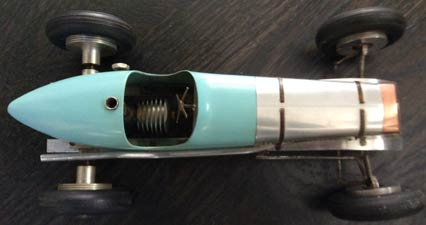 |
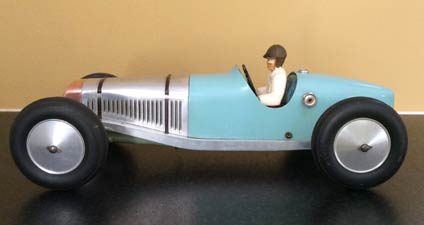 |
| Delage railcar, horizontal motor and direct drive | |
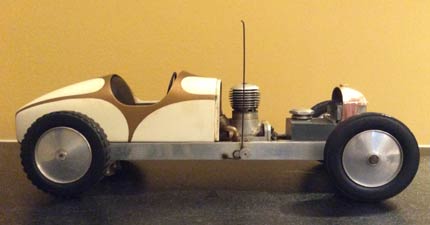 |
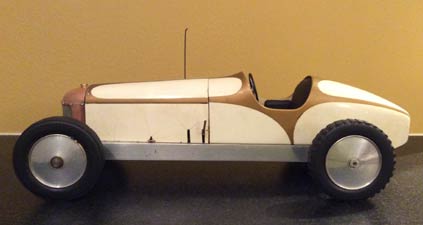 |
| Miller railcar, vertical front induction motor driving through a bevel gearbox | |
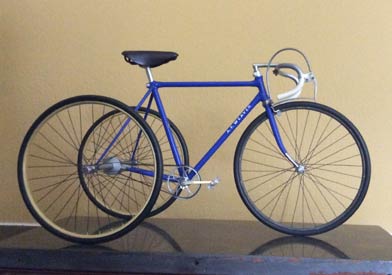 |
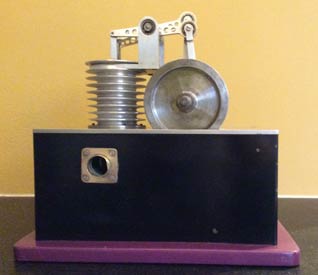 |
| Scale model of a Weaver tricycle | The 'hot air' engine |
It would be impossible to calculate just how many engines, cars and boats Arthur Weaver built in his career and happily a few have surfaced and been gathered together for this article, but a large number effectively have vanished. All that exist of these at present are photos in magazines. Here though are some of the items that have survived but for which we have no further information or documentation.
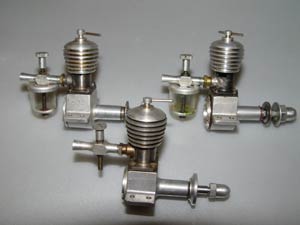 |
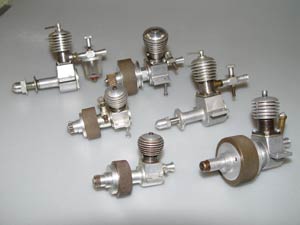 |
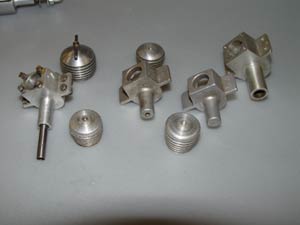 |
| Weaver/Ransom 1cc | Railcar motors | Demons? Crankcases by 'Colson' |
|
|
|
|
| Diesel motor variable induction timing | Early car motor | Serious racing motor, but for what? |
|
|
A few more engines believed to be the work of Arthur Weaver, certainly the design and inspiration if not the execution. The three 1.5cc engines are prototypes for the still borne Amco Atom, which eventually became the JB Atom and Bomb, the latter being 1cc in capacity. Arthur made the neat 1.5cc version with dark cooling jacket and the other two were made by Tom Crompton from castings obtained from Gerry Buck's collection which is where virtually all of the Weaver engines above came from. |
This article has had the longest gestation period of any we have ever prepared and there are so many people to acknowledge who have made the eventual publication possible.
First and foremost must be to Arthur’s daughter Gwyneth for the wonderful biography, several new lines of research for us to pursue, and constant updates along with numerous original photos. John Goodall has been particularly helpful, giving us unlimited access to all the items in his possession relating to Arthur and providing many of the modern images. Along with Alan Whitehead, John was also party in reuniting one of the hydros with its original motor.
A wonderful gesture from Gerry Buck’s daughter Gill was the donation of Arthur’s personal scrapbook, which runs from 1946 to 1954. Peter Hill, who became the custodian of ‘Gwyneth’ the boat, has provided the leads for the other two hydros, as well as recalling the connection with the Stratford Museum, which he visited in the 1980s. Stan Barrett, Mario Gandolfi, Tony Taylor and Fred Blois for personal memories of Arthur and Mary and original photographs. Eric Offen for recognising and saving NL 1952 and providing reference material, Ken Smith and the Westbury family for original photos.
©copyrightOTW2017
Postscript: Unbelievably, just before the final part of this article was due to be published, the postman arrived with a box of assorted material that included two important images below. The first is the only photo of a complete and original 'Weaver' Redex Cooper Bristol and the other of Arthur's own version of the same model. What makes these so interesting is that they were both taken within the last 20 years meaning that both these cars have survived although their current whereabouts is as yet unknown, unless anyone can help? The right hand photo was taken by Miquel de Rancougne with parts of his collection in the background.
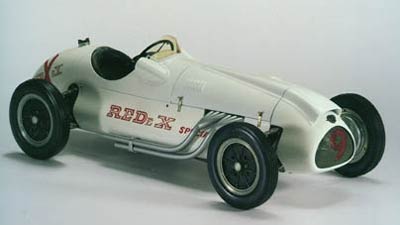 |
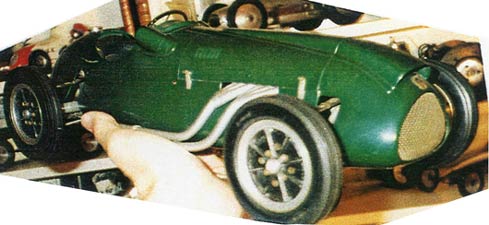 |
It has yet to be confirmed how many of these cars Arthur did build, from the articles it indicates at least three, and now we know that three have survived, are there more?
Update Sept 2017:- We were delighted to receive news, details and images of another original REDeX car built by Arthur for Myers representatives around the world. We now have confirmation that at least four of these cars were built and have survived, this one still with its original paintwork and ETA 29 motor.
|
|
|
| Sixty five years on, another testament to Arthur's skill | Front suspension details |
Update Nov 2017:- Thanks to the sharp eyes of Arthur's daughter, another survivor has been identified. This was also in the 'Spindizzy' collection but not attributed and may well have come from Gerry Buck's collection. It is another railcar, but quite early as it still has the plain rail guides and judging by the flutes in the bonnet is based on a Vauxhall model.
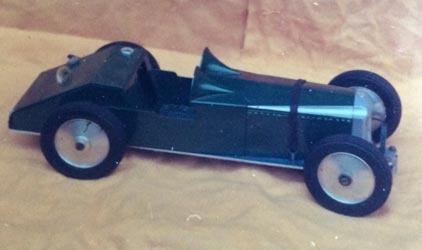 |
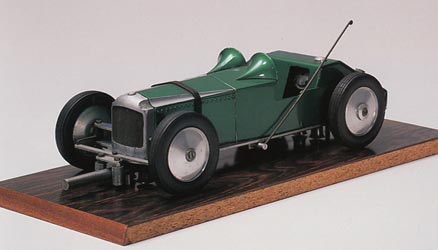 |
| As photographed by Arthur 1949/50 | Somewhere in America 1990s? |
Update August 2020:- Three years on from publishing the previous updates and after several appeals on the website and through Facebook, Arthur's own and distinctive Cooper Bristol has been located. It had apparently been consigned to yet another major auction house, the second time in its recent history. The car remained with the Weaver family until loaned to the Stratford on Avon Motor Museum where it was stolen in 1990. It must have either been recovered or sold on soon after, although it was never returned to the family. Since then we can positively place it for a while with Miquel de Rancougne through a dated photograph and later sold via Christie's in June 2002 for Ł2390. This was not the sale of Miquel's collection, which did not take place until 2004. The car then vanished again until it appeared at Bonham's where it was bought by its present owner, although he cannot recall when or where? It has suffered very little in the intervening thirty years, still without an engine, and in its original green paintwork, although it had gained a racing number prior to 2002. Arthur never did finish his in the REDeX livery.
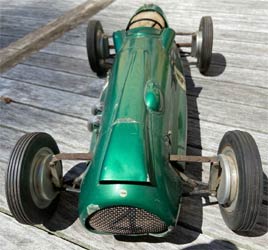 |
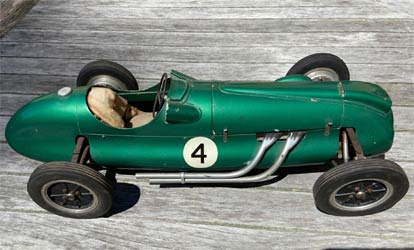 |
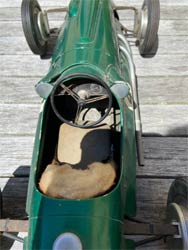 |
Our thanks to Murray Smith for contacting us and allowing us to publish his photos of the car as it is currently.
Update July 2024: Arthur's cars resurface, but in unusual circumstances.
As can be seen from the above updates, Arthur's cars do reappear on occasions, yet some have seemingly vanished without trace. One of his cars, the Vauxhall railcar pictured above appeared in the mammoth Spindizzies book published many years ago, but following the break up of the collection in 2017, it too disappeared. The entire collection was divided into three and spread between the Henry Ford Museum in Dearborn, The American Museum of Speed in Nebraska and the remaining items 'somewhere in Europe'. The 'somewhere' remained a mystery until we were sent a scan from a magazine revealing that the Louwman Museum in the Hague was the location, and even more remarkably, clearly seen, the Arthur Weaver Vauxhall railcar. We forwarded this information to Arthur's daughter but a visit to the Museum website and perusal of their collection catalogue did not reveal anything further, until another of those remarkable hapenstances over which we have absolutely no control.
Fast forward to June 2024 and two emails that arrived simultaneously, one from Arthur's daughter and one from his granddaughter Erica. Erica was in Europe and was visiting the Louwman with the prime purpose of searching out her grandfather's car and the email was short and to the point' I have found my granddad's cars'.
|
It was not until later that day when she could upload her photos that the significance of the plurality could be appreciated. The Curator at the Louwman had been very helpful, directing Erica to where the cars were and allowing her to photograph them. Our thanks to Erica for passing on the photos and information. The Vauxhall railcar we obviously knew about although there was no credit given to Arthur as the builder, either in the Spindizzie book or at the Museum. The family are now trying to get the Louwman to add the name of Arthur Weaver to these cars as the original builder. |
|
The complete surprise was Arthur's
model of Sir Malcolm Campbell's record breaking Sunbeam 'Bluebird'. This
does not appear in the book or in any of the myriad of photos we have from
the Spindizzie collection. The Sunbeam was last known to be in the
collection of the late Gerry Buck in the 1980s so we can assume that Jerry
Bryant bought it from the Buck family thirty plus years ago?
|
It is this car that caused the most intrigue amongst enthusiasts as it was Arthur's most famous build and many had seen it at Gerry Buck's house, but then, of course, it vanished. Wonderful that it should be rediscovered after all this time, and by Arthur's granddaughter as well, could not even have been scripted like this? |
|
We include the following photo, as the commission received from the Myers company to build a series of REDeX Copper Bristol models is well recorded and a number have turned up as related above. The only question at present is whether this is one of Arthur's or the one Rex Hays built, which was known to be in the Spindizzie collection. Only a look under the bodywork would confirm who built it.
